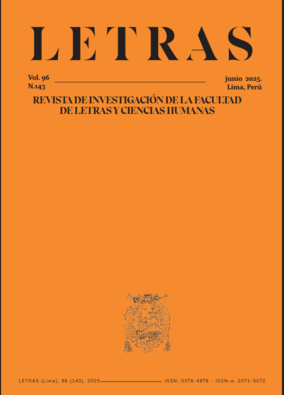Five versions of a triangle: film adaptations of “La intrusa” by Jorge Luis Borges
Abstract
This article offers a comparative analysis of the cinematic adaptations of Jorge Luis Borges’ short story “La intrusa”, originally published in 1966. The corpus covers five adaptations from different countries and decades:Ghazal by Masoud Kimiai (Iran, 1976), A intrusa by Carlos Hugo Christensen (Brazil, 1979), Oraingoz izen gabeby José Julián Bakedano (Basque Country, 1986), El tres de copas by Felipe Cazals (Mexico, 1986), and La intrusa by Jaime Chávarri (Spain, 1993). The article examines how each film reinterprets the story’s themes — desire, jealousy, loyalty, and violence— and reconfigures the main characters according to various socioculturalsensibilities regarding gender roles. In all the films, the chronotopic construction —necessarily heterogeneouswhen comparing productions from diverse cinematographies— reiterates the contrast between two oppositespaces: the country and the city, the interior and exterior of the home. This spatial dialectic overlaps with thegender dialectic that defines the relationships between the main characters. By exploring these films, the articleinvestigates the universal appeal and local specificity of Borges’ literature, with particular interest in the variousinflections that masculinity and femininity assume in successive audiovisual versions, made in heterogeneouscultural contexts. It also addresses some challenges of the audiovisual transposition of Borges’ narrative style,characterized by the radical subordination of character to plot.Downloads
Métricas alternativas
References
Aguilar, G. y Jelicié, E. (2016). Borges va al cine. Libraria.
Bakedano, J. J. (1986). Oraingoz izen gabe [film]. José Julián Bakedano Sarrionandia.
Barthes, R. (1972). Introducción al análisis estructural de los relatos. En AA. VV., Análisis estructural del relato (pp. 9-43). Tiempo Contemporáneo.
Borges, J. L. (1974). Obras completas. Emecé.
Borges, J. L. y Ferrari, O. (2005). En diálogo II. Siglo XXI.
Brant, H. J. (1999). The Queer Use of Communal Women in Borges’ “El muerto” and “La intrusa”. Hispanófila 125, 37-50. https://www.jstor.org/stable/43807132
Canto, E. (1999). Borges a contraluz. Espasa-Calpe.
Capalbo, A. (2011). La intrusión melodramática: Borges y Christensen. Digilenguas 7, 33-40. https://www.lenguas.unc.edu.ar/uploads/DigilenguasN7.pdf
Cazals, F. (1986). El tres de copas [film]. IMCINE, Casablanca Films.
Cédola, E. (1999). Cómo el cine leyó a Borges. Edicial.
Chávarri, J. (1993). La intrusa [film]. RTVE.
Christensen, H. C. (1979). A intrusa [film]. Carlos Hugo Christensen Produções Cinematográficas.
Contreras, G. (2001). Oscar Wilde, últimos días. Estudios Públicos 84, 369-378. https://www.estudiospublicos.cl/index.php/cep/article/view/825
Cozarinsky, E. (1981). Borges en/y/sobre cine. Fundamentos.
Di Paolo Harrison, O. (2019). Femicidio. La mujer como causa de despecho entre dos hermanos en conflicto emocional en “La intrusa” de Jorge Luis Borges. Acta Iassyensia Comparationis 23(1), 51-62. https://doi.org/10.47743/aic-2019-1-0006
Faber, S. (2004). El mundo está en todas partes: la subversión fantástica de Jorge Luis Borges y Bernardo Atxaga. Revista Canadiense de Estudios Hispánicos. 28(3), 519-539. http://www.jstor.org/stable/27763942
Fernández Penas, M. (2016). El cine como creador de identidades nacionales. Un recorrido por el cine vasco. Revista Observatório 2(3), 102-118. https://doi.org/10.20873/uft.2447-4266.2016v2n3p102
Fitzgerald, D. (2006). Borges, Woman, and Postcolonial History. Romance Studies 24(3), 227-239. https://doi.org/10.1179/174581506x147632
Freire, H. (2003). Borges y el cine. Inti. Revista de Literatura Hispánica 57, 153-158. https://digitalcommons.providence.edu/inti/vol1/iss57/12
Gil Mariño, C. N. (2019). Río de Janeiro en las cintas de Carlos Hugo Christensen. Novedades técnicas, industrias culturales y Estado en las imágenes político-culturales de la urbe. Nuevo Mundo Mundos Nuevos [on line]. https://doi.org/10.4000/nuevomundo.77002
Hutcheon, L. (2013). A Theory of Adaptation. Routledge.
Kéy, H. (1999). Le cinéma iranien: l’image d’une société en bouillonnement. Khartala.
Khosrowjah, H. (2015). Gavaznha/The Deer. En S. Haenni, S. Barrow y J. White (Eds.), The Routledge Encyclopedia of Films (pp. 241-244). Routledge.
Kimiai, M. (1976). Ghazal [film]. Parviz Sayyad.
Lee, A. (2005). Brokeback Mountain [film]. River Road.
Mercader, M. (1989). Los intrusos. El hambre de mi corazón (pp. 190-199). Sudamericana.
Molloy, S. (1999). Las letras de Borges. Beatriz Viterbo.
Oter, J. y Zunzunegui, S. (Eds.). (2016). José Julián Bakedano. Sin pausa. Zentroa y Universidad del País Vasco.
Panesi, J. (1999). Mujeres: la ficción de Borges. Espacios de crítica y producción 25, 58-64. https://www.borges.pitt.edu/sites/default/files/Panesi%20Mujeres.pdf
Pérez Bernal, Á. M. R. (2003). El texto bíblico en “La intrusa”, de Jorge Luis Borges. Escritos. Revista del Centro de Ciencias del Lenguaje 28, 105-124.
Ramírez, R. y García Toro, V. (2002). Masculinidad hegemónica, sexualidad y transgresión. Centro Journal 14(1), 5-25. http://redalyc.uaemex.mx/pdf/377/37711290001.pdf
Robles, X. (2019, noviembre 25). La izquierda en el cine mexicano del siglo XX. Novena parte: La verdadera época de oro del cine mexicano. La Jornada Zacatecas.
https://ljz.mx/2019/11/25/la-izquierda-en-el-cine-mexicano-del-siglo-xx-novena-parte-la-verdadera-epoca-de-oro-del-cine-mexicano/
Santillán Buelna, J. R. (2016). Un siglo de cine político mexicano. Ámbitos 33. https://doi.org/10.12795/Ambitos.2016.i33.03
Sarlo, B. (2003). Borges, un escritor en las orillas. Seix Barral.
Shams, S. (2012). Deux cinéastes iraniens en quête d’une identité perdue…. Les Cahiers de l’Orient 106(2), 35-45. https://doi.org/10.3917/lcdlo.106.0035
Somerlate Barbosa, M. J. (1998). Chorar, verbo transitivo. Cadernos Pagu 11, 321-343. https://ieg.ufsc.br/public/storage/articles/October2020/Pagu/1998(11)/Barbosa.pdf
Zunzunegui, S. (2016). Perseverancia. En J. Oter y S. Zunzunegui (Eds.), José Julián Bakedano. Sin pausa (pp. 13-14). Azkuna Zentroa, Universidad del País Vasco.
Copyright (c) 2025 Letras (Lima)

This work is licensed under a Creative Commons Attribution 4.0 International License.
Este obra está bajo una licencia de Creative Commons Reconocimiento 4.0 Internacional



















